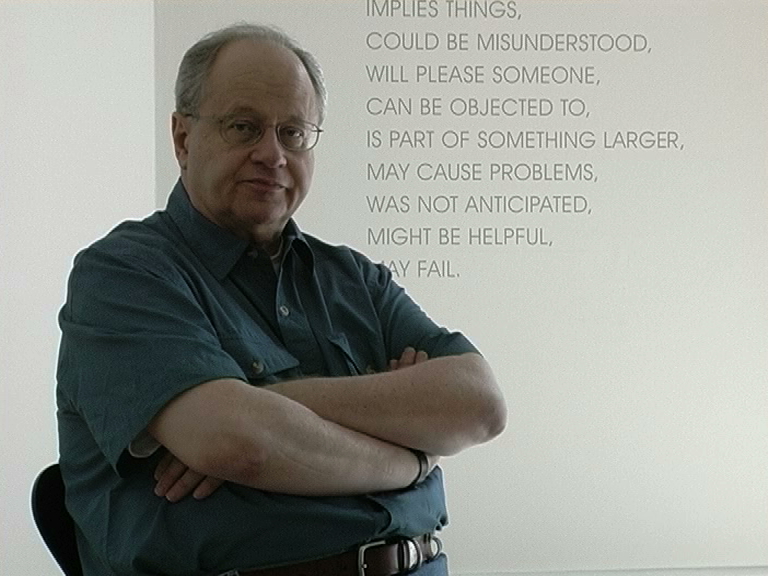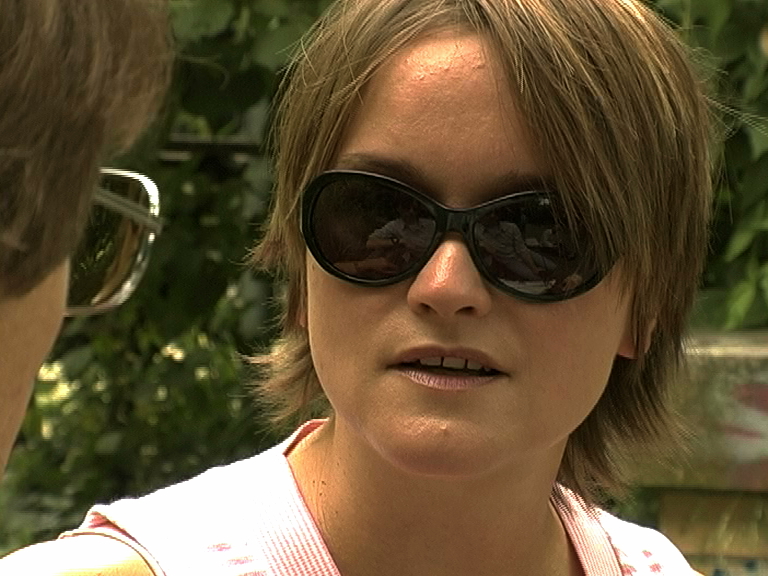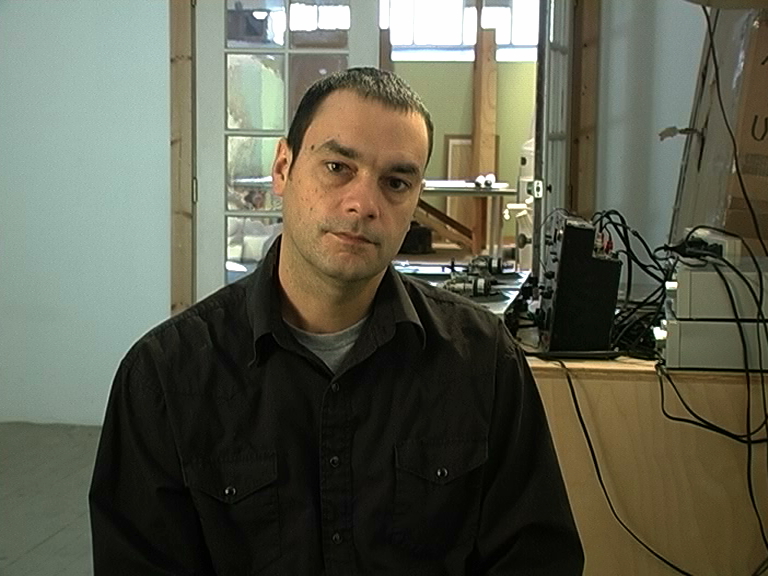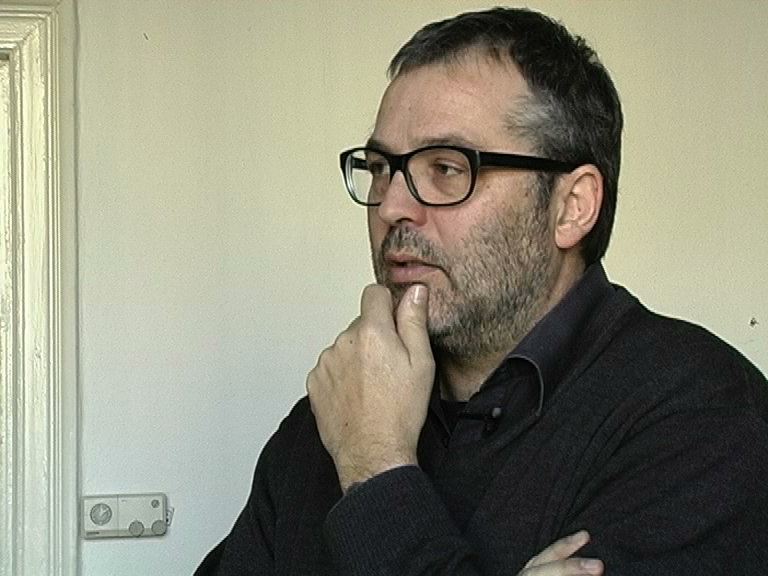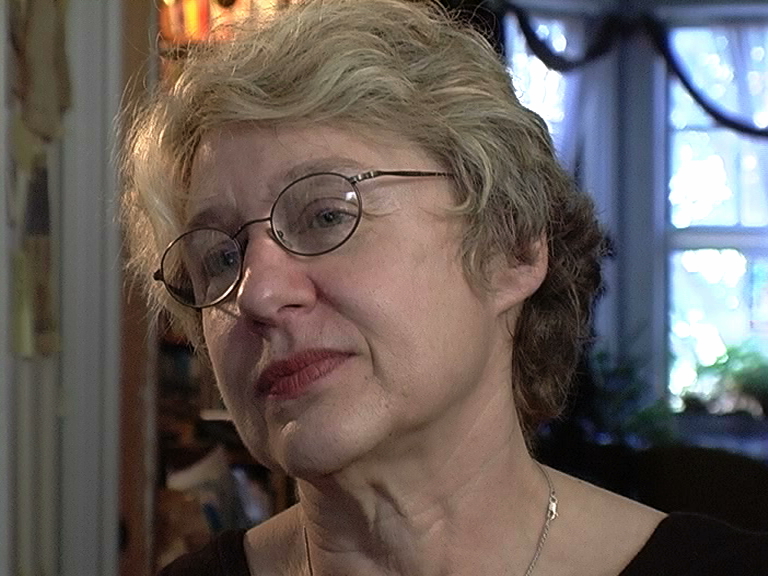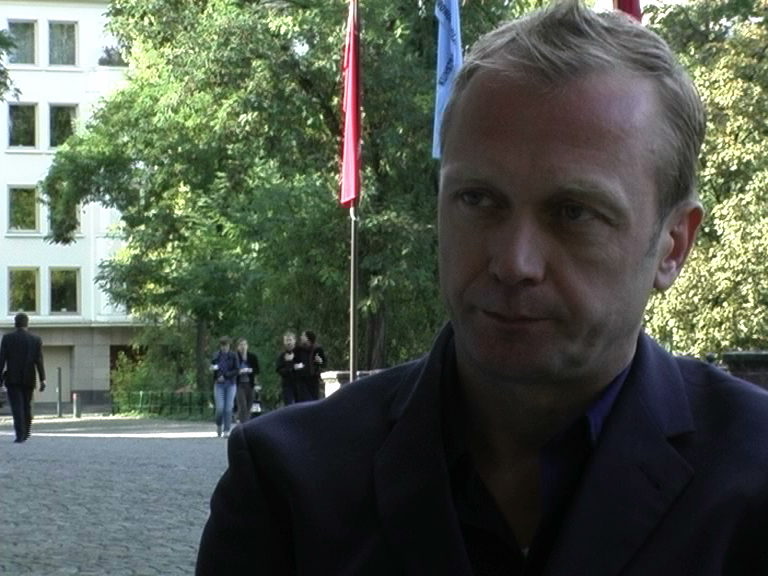S.R.: You decided not to get portrayed as an image of yourself. And so maybe I should ask: Are you not only a no-studio artist, maybe also a no-portrait artist? Or is it a dumb question?
M.A.: No, it’s like what I told you before. It’s this question of personal subjectivity, and I never understand, I never know why it’s placed into a representation, be it video or whatever. Go on.
S.R.: I was fascinated as a student by some of your works, specifically by the concentrated gestures you made in, for example, two works I liked very much, that was “Sculpture” in Münster in 1977, I was really impressed by it. And “Installation” in Kunsthalle Bern, that was 1992. We talked earlier and you said, generally, I’m not considered as a typical conceptual artist. But how would you call your approach; do you have a specific term for it, or how your work should be called?
M.A.: It would probably be best just to say that… I think of myself as a conceptual artist, and I think others think of myself as a conceptual artist, but at the time I began art, I… this is what makes it so difficult; I mean, it’s very difficult to talk, but anyway, I give it my best. At the time I began working, I was thinking about being honest and doing my early work. It really came from, the early work really came about due to formal reasons, and those reasons, sort of, were questions I had about modernism, and in particular the autonomous object, and let’s say all the arbitrary decisions which went into making that object. I found them fundamentally disengaged with everything around it, both – it seemed to me at least – both physically and architecturally, and then eventually, later on, I should say, socially and politically. So, as my practice evolved I realized that the structures that I used to determine, for instance, how the forms would take place, had some kinship or relationship to the way artists were working in conceptualism. So I think that that‘s what drew maybe artists and historians towards my work. Even though it was so formally based, they realized that these methods or ways of working were quite similar to conceptualism; that was probably in the late 70s or early 80s, so then it became more obvious. But earlier on, in as early as 1969, I was in several exhibitions which were conceptual exhibitions. It was even people, way back then, that were seeing what I was doing a sort of conceptual. So I can’t deny that. I mean that was part of my history. But I was pleased. Well I don’t want repeat what I said. I don’t know if that answers your question.
S.R.: Sure, that’s one approach, yes.
M.A.: Well, I don’t need to say you really asked me about „Sculpture” or this project so far. I’m just leaving it like that.
S.R.: Yes, maybe we can keep this in mind and continue thinking on it in Kunsthalle Bern. What I thought on behalf of this work, you said you had some formal considerations, you mean you had a lot formal considerations but also social and political considerations. Especially this work for me is so condensed, it’s so focused, and in the same way – and that is what I like very much – it was in a way sculptural, because if you enter this space with all this – what do you call it in English, radiators? From the heating system? You directly have a kind of sculptural impression, I think, and very easily you can understand then that there is a circulating system, but this is circulating system getting formalized through its pipes. Do you call them pipes? Or tubes? For me it seems to be something like you set in scene a concentration, a focus, in one room that is related to all the other rooms of the whole structure of the building, of the presentation rooms, and this is what I liked very much. And I think in one way it’s easy to understand, but it’s so pure, it’s concentrated, and this is, that was really strong for me. And if you start from this point, and I think it’s very simple to understand if you come as an outsider to this room, to this space, you can, as a second step maybe, you can get the reflection on the system. The heating system in relation to the architectural, institutional spaces. Is that right?
M.A.: Yes, absolutely. If we go back, though, this is a good example of this question of formalism and conceptualism, because this operation was in my mind… this very careful regress of, what, I might say, structure which, I suppose, is familiar with those people interested in conceptual tendencies, but it’s got all these heavy formal relations with the viewer and with their architectural frame. So I’m gonna start here to say what I like about it is that it so easily shows how the sign of conceptualism works very conveniently with a highly formalized installation, and that, just the idea of… We take, like, the idea that is so much stereotyped of the mind and the body, and Conceptual Art sort of entertains the mind whereas the rest of art entertains the body. Well, this tries to put those two together and suggests that the warmth and the heat is one way of understanding the reception of the work in space, yet the mind understands the way it’s put together, and why it’s put together this way, and particularly, hopefully, the viewer understands that… Once again, the tendency of architecture in the museum to streamline its room and make the outlets for heating and air conditioning less and less and less noticeable, and this work is one thing which – I’m going into the description of the work a little bit and why I did it. This work reverses that and turns these outlets and these air condition elements into or better that are being taken away from the space as much as possible, and puts it back into the space, to practically the center of the space. That’s one thing, and then that work also is an attempt to reference the absolute need for an infrastructure. This is very similar to what I was just saying, but with the pipes on the outside of the walls, it takes absolute notice of an infrastructure in the building, which can only begin to come from outdoors, just like the rest, and then, hopefully, what that generates is the idea that, sure, I mean that the museum is not only dependent upon the water that comes from outdoors, and the energy that comes from outdoors, but also the banks, the transportation network, every other aspect of servicing this building, is dependent upon those services. So, anyway, those are the two main, those are the two most important aspects, I suppose, of that work. I’m just trying to think of what you said, though.
S.R.: No, it was perfectly answered. What I was trying to ask is how you see your approach onto this work. I would like to come a little bit more to the beginning of your work, as you started as an artist. Is it possible to say something like what influenced you very strongly or what was something like a starting point for your work? Maybe literature, or in art, or in the world in general, I don’t know.
M.A.: It’s very hard, very hard. Certainly contemporary works of art and pretty much the dilemma I saw within them, and just the pragmatics of… I can’t say it.
[lange Pause] I just go into saying the… I just really want to somehow demonstrate a response to the questions I have about works of post-war and the tendency of post-war modernism. So that was one of the more important driving forces.
[lange Pause] Let me look… because actually I have written about this. But I think I’ve kept it away from… There is also this… The war was ramping up. There is a need to realize that, pretty much, that I, as a younger person, had to find alternatives to a very entrenched way of thinking that lead us into the war. I felt that anybody that could ought to give it a try at least; so that was another reason.
The art really attempted to constitute itself by using pre-existing elements that people were already familiar with within architectural space, early on, and could read and were not abstracted from other, some other personal choice, necessarily – individual choice and decisions – which were much harder to read. What happened is, of course, that the work of art was understood by the elements around it, contextually, and also there is, I should say, there was another force. It wasn’t all cut and dry like I make it seem because there is a very, an intuitive force, where I wasn’t sure of what I was doing, I just had to produce and produce and produce to get an idea of what I was doing, and make a lot of mistakes, and that was also another way of shaping what I wanted to do. So that’s where it…
S.R.: Shall I continue with the next question?
M.R.: Well, I’m sure there is a lot more there. I just (laughs) but it’s very hard to get a hold of it.
S.R.: I would like to ask you if you – maybe it’s very hard, but is it possible to say, something like what is the goal or the aim of your work? Is it possible to say something like this?
M.A.: Yes, it’s possible… More and more, each of the works, hopefully become critical tools which the viewer can utilize in order to understand not only the problem that my work is underscoring in that particular work, but also can take in use elsewhere for other problems that they define. That’s sort of the goal and what I attempt to do just fundamentally within the work.
S.R.: If you think in a historical sense: What happened with conceptual art? Maybe I try to formulate it as a break with modernism? I mean if it’s allowed to think in this continuity, this flow of history, this linear development, then I think conceptual art in the second half of the 60s to the 70s was something like a break with the tradition of art; maybe there where some influences of Pop art, and much stronger influences from Minimal art. Do you think that this, maybe that’s called paradigms, conceptual paradigms. These paradigms, do they have to get renewed? Or are they still in function? How would you consider this complex?
M.A.: I’m sorry, I’m not sure that I understand the part of conceptual paradigms. Does that have to do with the tradition now that conceptual art has occupied? Is that what you mean by conceptual paradigm?
S.R.: That’s hard to say, because that is the hubris of this question maybe, because as I understand it, Conceptual art is a strong critique of modernist thinking and writing of traditions specifically in the arts. Like, let’s say Greenberg and so on. In another way, or some other ways, some of the politically reflected practices of Conceptual art can be thought in relation to modernist interests, like in Bertolt Brecht or Walter Benjamin or in a specific Marxian or Freudian tradition, for building tools for reflection, of reflection. But, if I see Conceptual art in the tradition of art, it’s something like a break; it’s a different kind of working, it’s a different kind of working with spaces, with architecture, with writing, with… the whole set of terms of art gets reflected, some get destroyed, some get renewed. But the formation of the so-called, or I will call it, conceptual field of practices, I don’t want to figure it down to one linear development. I think there is a wide field of approaches; and there is a discussion between these different positions. But if we consider it like this, from our perspective, 20, 30 years later, how was the development? Is it that the different positions are still working in their own conditions and they are still able to reflect the institution? Because of course we have to see that the institution changed a lot in the last 20, 30 years and society has changed a lot, the political behavior changed a lot. How do you see the – how is it possible to take this screw a little bit faster, a little, not faster, what you call it, closer? Is it possible to do that?
M.A.: Absolutely, absolutely. I think I do understand your question; you made it very clear. It’s an odd problem. This is where I come to it, it seems like an art problem to me, because many artists or many authors, I should say – that’s broader than just artists – were very happy with the category, and just their job they saw was to maintain the category – and they would all disagree with me – and not push the limits of the category or at least search for the limits of the category and see what was beyond it. I think that, very briefly, I think that is, that became the problem of a number of artists, authors, who have this sort of concept, who started out with this conceptual practice.
I think it really goes back for me, I can speak about myself better, that it really goes back to the author, the artist, willing to take a risk, knowing that the work is going to fail, perhaps fail, or will fall flat or one thing or another like that, in order to move on, and that’s the only way that movement will be made. So when you talk about turning the screw a little faster, that, I think, is contigent upon the artist being able to truly experiment, truly, truly experimentand not very… Just very briefly that’s what I have to say. I think I understand precisely what you’re saying or what you’re asking, I hope I do… I mean this is a really important question; I’m sorry I’m not describing it better or answering it better.
S.R.: Maybe I’m going to insist a little bit.
M.R.: Go ahead. Well, I mean, it’s really a quite important question.
S.R.: I can ask from the opposite of, for example: Is it possible to renew the conceptual paradigms, to start from below, from zero? To start again with the conceptual project in this time?
M.A.: Oh! (chuckles after a break)
S.R.: Because, maybe I say something more, because we have a lot of – we as a collective in the art world – have a lot of experience with different developments in the last 20, 30 years; for example some painting connections coming back and back as „retro“ styles.
M.A.: Sure, sure.
S.R.: In sculpture also we have some different revivals of, for example steel or whatever. We have revivals of art in the public sphere, in German: Kunst im öffentlichen Raum. And also just here in Los Angeles that ceramics art is coming back. It’s always the question who is taking, considering this, who is interested in that.
M.A.: Yes but so many of those developments depended upon style, whereas conceptual art didn’t necessarily depend on – wasn’t contigent upon style, it wasn’t contingent upon materiality – whereas all the things you describe in art. It would seem to me that it would be possible for a conceptual record to come about and conceptual methods to come about again, and there is plenty of room for absolutely work that we have never seen and never thought about, to derive itself from that. I really believe that, I really believe it. Because these are just, from my understanding of Conceptual art, these are just approaches to art making, for the purposes of intellectual discovery. With that in mind I don’t see what the problem is, unless, like I said earlier, one gets locked into what they are doing and can’t move, sees no hope or wish for future discovery. I don’t know if that explains it, coming back the other way. You put it, once again, in a really good way.
S.R.: I mean, what you said, Conceptual art was never – for you, you said – in my opinion it was never a kind of a style, but when I look through the magazines, the art magazines or I go to some exhibitions of contemporary art, sometimes I have the feeling that younger artists, or students, just pick up a different style of surface, and they are not concerned with the whole epistemological background or the institutional background, and so sometimes I’m afraid that, – that is the basis for my question – that conceptual aesthetics – I mean if it’s aesthetics, it’s already over, I mean it‘s finished?
M.A.: No, I totally agree, I totally agree, and also the younger people – I see what they believe to be conceptualism just constantly co-opted and co-opted for their own use, and it becomes sort of actually fascinating, it becomes sort of the ideology of conceptualism, but not the real workings of conceptualism. It’s a fascinating problem. But I think it’s, I really feel it’s not doing the job that it could be doing, and particularly in this area of inquiry and examination, it rarely does what conceptualism was able to do. I keep coming back to this, I’m sorry.
S.R.: Of course there cannot be something like a manual for Conceptual art, but one thing also for me in this film, one question is: how is it possible to understand this circle, or this, maybe it’s more something like a spiral, that the work, or the practice of Conceptual art is taking. For me it’s very interesting to understand the mind, the epistemological background. For example, I know Hans Haacke very long and I know that he is very pragmatic. For example, he told us in this interview, he was asked to participate in this Utopia Station which was in the Venice Biennial and then in Munich, and he said: I’m even not able to think what it is, Utopia, because I’m so in the world. So it’s not possible for me, and I cannot understand this. And this is the point which I always try to understand. What is the moving energy in the personal thinking?
M.A.: And isn’t that interesting that you brought up Utopia Station; I didn’t see it, but from the little I’ve heard of it, it seems to have utilized artists which actually took on the supposed canon of conceptualism, and they are included in Utopia Station, and obviously utopia is an extraordinary speculation which you didn’t find in conceptualism, or that much. It was really dealing with the real world or the existing world around us. So Hans Haacke is absolutely correct. But anyway, to get back… I got diverted on that, that’s interesting. Do you want to state that again, that last part?
M.A.: I guess what I thought is that your question was really – when you were talking about this coming back upon itself, perhaps you were alluding to the institution becoming more and more a forceful player in determining what the artist does, and as well as the market becoming a determining player. And that, I think, is the case, and that’s what not only curators but gallerists and people like this do hope, this movement back to at least younger people feeling that there is a place where they can take on the veneer of Conceptualism. But I’m not sure if that’s really the question that you are asking, because you are looking for more of an epistemic place, … a place where, I guess, the epistemology of Conceptualism can begin again. Is that part of this question again?
S.R.: Yes.
M.A.: I think it never went away, actually. It’s always appreciated, particularly in Europe and other countries, I’m sorry, on other continents as well, maybe not so much in the U.S., but I think when the viewers experience a work that doesn’t have some debt to the museum, or doesn’t have some debt to the gallery, they really see the difference, they understand the difference and, like I said before, they can appreciate it. At the same time we have this, in the background, we have this return going on; like with the younger artists who are returning. I’m not sure I’ve really answered your question?
S.R.: Yes, I think so, yes. Maybe it’s not possible to answer the question, in one way. Maybe we have to constantly work on this answer. Maybe every new work is the effort to try to answer this question. But I think it’s very important for me, in my perspective, it’s very important to have this question, to have it in concern, to know about it.
M.A.: Yes. I think, certainly it’s an important question. But I think even more important is the fundament of what the job of the artwork is. If it’s not any longer a place to move forward and develop and experiment with new ideas, then it leaves us to ask them what is its purpose, what is the situation of… how it situates itself with one thing, one style or the next style, one ethic or the next ethic. Sorry, I’m not being very clear about what I’m saying. So, once again, this idea of intellectual discovery should be permanent – so even if you are doing a painting or a sculpture. But we don’t receive very little of this, and I guess that’s why I’m bringing it up. And that for me is the most fundamental question.
S.R.: Maybe I can take up one of your ideas of this last statement and turn the perspective a little bit around. Do you think it’s important that every artist with a conceptual background has to develop his or her own medium, or do you think that it’s also possible to work with painting, conceptually?
M.A.: I never understood how there can be such a thing as conceptual painting, quite honestly. But that aside, I think when the artist looks at the problem and says, okay, how can this best be articulated? And it might be painting, sculpture, it might be with grass, I don’t know. But I think to, sort of putting the materiality ahead of the idea is perhaps a bad way of, not a good way of really demonstrating a problem. I don’t know if this does answer your question, damn it.
S.R.: Yes, it was an answer, because it’s always a question of the context. If I understood it right you were implying the context.
M.A.: Absolutely. That drives the decision as to what to use. Absolutely.
S.R.: For example if you want, I mean it’s not possible to translate your work in Bern to a painting, but I can imagine – just as a vision or a fiction – I can imagine if you decided to do it with sculpture, it would be different. But it has some sculptural aspects. That, for me, as I said in the beginning, that was one of the interesting things that I was so irritated by it, so it drove me to a different state of mind because I understood something that I couldn’t see before.
M.A.: I don’t know why physical bulk can’t play a role in Conceptual art, I‘ve never understood it. And I think perhaps it’s a better way even for me to question the problems of the institution, to not deny them or not to mitigate them or make them smaller in any way whatsoever, but it’s just to be frank about it and forthcoming about it, and that’s what the work does. If it’s read as sculpture, that’s great, but the undercurrent is that it’s not a sculpture, and that’s the beautiful part of that particular work. But it certainly has the presence of, like you`re saying – absolutely has the presence of a sculpture. It goes back – that’s another aspect of the work – I had read often on about how… Well, this is off the point. It’s about sculpture and Minimalism and the use of these types of buildings, and what I was… reading was like the continuity of Minimalism as it took like van Abbe Museum or the Kunsthalle Bern and places like that. And I thought about some of the Minimalist projects that were written about that way in those museums that were very symmetrical in their organization. They were really often very discontinuous in a sense, they were made for… certainly made for perhaps the museum show, but also with the mindset of being broken up later, into gallery exhibitions or wherever, but to end up somewhere within collections. This idea of continuity was almost a claim which shouldn’t ever have been applied to these works, I didn’t feel. This work also attracts that idea a little bit of trying to argue that case. Although by this time people were probably realizing it, but it doesn’t matter.
S.R.: Maybe lets take a small concern to the question of site and site specificity. To put it very – I don’t want to say – radically, but to think it to the end. Like in your work in Bern, in the Kunsthalle… site specific work means for me that if the exhibition is over, the work cannot exist any more. Because, like in this work, it’s only documented; after that, the space will be rebuilt – or how do you see that?
M.A.: Absolutely that way. Also it’s pretty hard, almost impossible for these works to be done elsewhere. They are very specific to both the time and the space. And, yes, like you say, once the exhibition is over – that’s it, they can’t be transferred to some other place without a tremendous amount of modification, and then they lose their meaning at that point. If I don’t care about the original meaning, that’s fine, I could do that, but I do so much, and these works are so specific to the context that I want to hold on to that. To move it would also suggest that the first meaning has little merit or little importance to me, and that’s the other reason I don’t do that.
S.R.: Does it ever happen that somebody took a piece of it and try to have it like a fetish and ask you to sign it or something like that, something like a valuable piece of these types there?
M.A.: No, I have never run into that. Somebody told me that they had a piece of one of my old works, just a small piece. I don’t know if they are doing that.
S.R.: There is only one question left, there is a last question and it’s a little bit personal in a way, because I’m also interested in your mode of working, or your interest in working and, maybe, a little bit, your habits. And the question is: Can you imagine what would be your ideal typical daily work as an artist?
M.A.: Well, it would primarily turn around working on my artwork, or if I’m engaged in school I would work at school, but if it’s working as an artist on my artwork it’s not something that starts at one time and ends at another. I try to use every day of the week, seven days, and I attempt to do everything I can within that day. I mean, it’s as simple as that. But some of these things, some of this research takes years to do, and so, if I have, sometimes I‘ll dedicate a day to just do the research, sometimes I’ll dedicate a day to just answering letters, and sometimes I’ll dedicate a day to something else that has to do with the work. That’s pretty much it, it’s really actually quite simple.
S.R.: So, thank you very much that you dedicated two hours to us, to our work. Thank you very much.
M.A.: Ok, so, I’ll probably scratch out. Thank you. I’ll probably scratch out a lot if I see a lot of duplication because there is a lot of duplication or redundancy. If that happens I would absolutely refuse. Usually the institution, and I have an agreement that everything is just granted. Like with these pipes, they were resold for construction, for housing or something like that. They were sold at a very low rate so that people can afford them, we didn’t have the money. I always try to build in something ahead of time, so that; and how this piece of plaster from this one work – it was just a plaster letter – it seems like the museum threw away all the other plaster letters. I don’t know, I don’t know how it… It wasn‘t thrown away also. The funny thing about these works also is, if I had the exact same conditions, they could be built because they are not built out of really exotic materials. It’s not like trying to reconstruct a brushstroke or something like that. They are just really all pretty much all simple materials that are around and pretty existing.
S.R.: Not marble or whatever.
M.A.: No. Well, there is one work which is granite, but it’s a permanent outdoor sculpture, and I’m a sort of mimicking the idea of an outdoor granite sculpture with it. (laughs)
S.R.: Which one is that?
M.A.: Oh, it’s in San Diego, at the University of California, and it’s a granite drinking fountain; it’s on a long walkway, in this grassy area, which is actually a pathway between buildings. [Unterbrechung]
It’s one of the few objects on the whole campus which shows the origin of that campus, or its prior function at least. About 40 feet in front of that almost in the walkway. So that’s the first, the second thing is a flagpole with the American flag on. On that same walkway I put a drinking fountain in granite right here, and it’s only to… I made sure that what it did… It looks like a standard fountain, except granite; it’s made exactly like into 1/32 of an inch, precisely like a middle fountain, one of the most popular ones used throughout Southern California. It only is… this logic which starts out very materially, about how materials – this is unfinished granite, this is finished granite. This is very overwhelming to the viewer and the body; this is made for the body, etc. You keep going back and forth, and you can see all these oppositions until you get into their function – this was obviously for war, this is done to utilize the peaceful resources – and things like that. So the students coming to it can develop all the way down those lines, if they chose; maybe they don’t chose.











